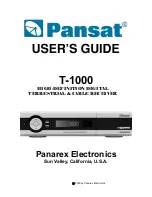
Other connections
10
84
En
1
Use an i.LINK cable to connect one of the i.LINK
connectors on this receiver to an i.LINK connector on
your i.LINK component.
• The arrow on the cable connector body should be
face down and lined up with the arrow below the
connector on the receiver for correct alignment. The
i.LINK cable should be inserted straight into the
connector so that it snaps easily into place. If not
connected properly the receiver will not be able to
recognize any connected components. Note that the
i.LINK cable is fragile and can be broken easily if too
much force is used when connecting.
2
Assign the i.LINK component to the input you
want, then make any necessary output settings on
the component.
See
Assigning the i.LINK inputs
on page 89 to assign the
component to an input on this receiver. Follow the
operating instructions that came with the component to
make any necessary output settings.
Note
• You can connect several components together using
i.LINK. See
Creating an i.LINK network
below.
About i.LINK
i.LINK is a trademark name for IEEE1394, a high-speed
interface for digital audio, video and other data found on
personal computers, digital camcorders, and other kinds
of audio and audio/visual equipment. A single i.LINK
connector can both send and receive data at the same
time, so only one cable is required to connect compo-
nents for two-way communication.
“i.LINK” and the “i.LINK” logo are trademarks of Sony
Corporation.
About PQLS rate control
Pioneer's PQLS (Precision Quartz Lock System)
technology provides high-precision digital audio from
DVD-A, SACD and audio CD sources when you use the
i.LINK interface. A precision quartz controller in this
receiver eliminates distortion caused by timing errors
(jitter), giving you the best possible digital-to-analog
conversion from the digital source.
To take advantage of PQLS, you must have a player
compatible with rate-control, and it must be switched on
and connected to this receiver through the i.LINK
network.
Creating an i.LINK network
Using i.LINK it is possible to chain up to 17 components
together so that the digital audio and control signals
from each component is available to other components
in the network. With the addition of an i.LINK repeater,
it’s possible to connect up to 63 components.
i.LINK connectors come in 4-pin and 6-pin configura-
tions. This player uses the 4-pin connection, but the two
types can be mixed on a network.
This receiver is compatible with i.LINK Audio (A&M
protocol) components, such as DVD players. Note that
when connected to i.LINK MPEG-II TS equipment (such
as a digital satellite tuner), i.LINK DV equipment (such as
a DVD recorder or DV camcorder), or an i.LINK-equipped
personal computer, audio and video signals are not
transmitted, and connecting to these devices sometimes
causes network interruptions. Check the operating
instructions supplied with your other i.LINK components
for compatibility information.
This receiver is DTCP (Digital Transmission Content
Protection) compliant, so you can play DVD-A, DVD-
Video, and SACD i.LINK audio.
PLAY
PLAY
AUDIO
POWER
AMP
IN
PRE OUT
AUDIO
PHONO
FRONT
SUB W
CENTER
SUR-
ROUND
BACK
SUR-
ROUND
SUB W.
CENTER
SUR-
ROUND
CD-R/
TAPE1/
MD
TAPE 2
MONITOR
CD
IN
IN
IN
OUT
IN
OUT
VIDEO
AUDIO
S2 VIDEO
USB AUDIO
S400
(AUDIO)
OUT 2
OUT 1
(CD-R/
TAPE1/
MD)
(DVR/
VCR1)
(SAT)
IN
(CD)
(TV/
DVD)
(DVD/
LD)
(DVD/
LD)
IN
DVR/
VCR1
OUT
DVD/
LD
IN
(DVD/
LD)
IN
Y
P
B
P
R
P
B
P
R
2
RF
IN
IN
IN
Y
P
B
P
R
Y
P
B
P
R
Y
TV/
DVD
IN
SAT
IN
IN
IN
IN
IN
OUT
OUT
OUT
IN
IN
IN
VCR2
OUT
IN
VCR3
OUT
IN
1 IN
REC
REC
OUT
DIGITAL
MONITOR
OUT 1
MONITOR
OUT 2
MONITOR
OUT
COMPONENT VIDEO
ASSIGNABLE
MULTI CH INPUT
RS-232C
2 IN
3 IN
4
IN
5
R
L
R
L
R
L
R
L
(Single)
1
(Single)
2
(Single)
R
L
R
L
R
L
R
L
R
L
IN
6
ASSIGNABLE
CONTROL
IN
3
1
2
(AUDIO)
S400
i.LINK-equipped component
















































